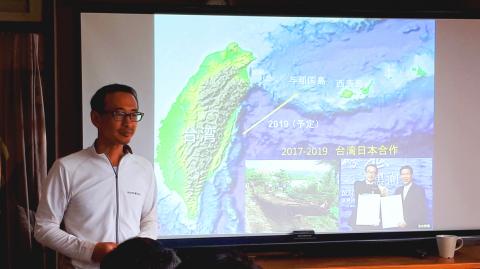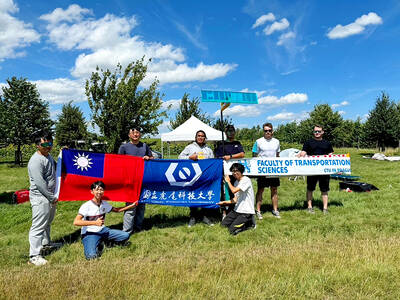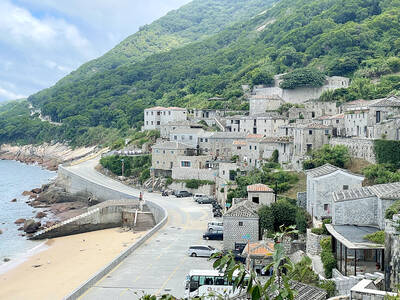The verification by Yousuke Kaifu that Yonaguni Island is visible from Taiwan underscores the Japanese anthropologist’s theory that his ancestors could have migrated to Japan from Taiwan.
Kaifu is a proponent of the theory that people migrated to Japan from Taiwan via the Kuroshio Current.
To test his theory, the National Museum of Prehistory and the Japanese National Museum of Nature and Science have collaborated on a project titled: “Navigating 30,000 Years Ago: Crossing the Kuroshio Current.”

Photo: Huang Ming-tang, Taipei Times
If Yonaguni Island was visible from Taiwan, it could have been an impetus for those living there to travel to the island, National Museum of Prehistory assistant researcher Agilasay Pakawyan said.
Humans are known to attempt risky endeavors and it is possible that even without a direct line of sight some people would have nonetheless put to sea for the sake of exploration, he said.
Taiwan is 1,253 times the size of Yonaguni and even when the weather is good, residents of the island can only see the Central Mountain Range about 10 days a year, making it much more difficult to see Yonaguni Island from Taiwan.
However, based on rumors that Yonagani Island is visible from either the Central Mountain Range or Sandiaojiao (三貂角) in New Taipei City, Kaifu visited Taiwan in 2017 and confirmed, after three days, that Yonaguni Island is visible to the naked eye when viewing at an altitude of 1,000m on Taroko Mountain (太魯閣大山), Agilasay said.
The results of Kaifu’s observations were published in Japan in March last year.
Meanwhile, a canoe launched as part of the project on Monday from Changbin Township (長濱), Taitung County, crewed by five and relying on the stars to stay true to ancient navigation techniques, arrived at Yonaguni Island on Tuesday.
The distance between Cape Wushibi (烏石鼻) near Changbin and the coast of Yonaguni Island, one of the Yaeyama Islands, is 205km when traveled in a straight line, but the closest point from Taiwan to Yonaguni is Yilan, which is only 110km away.
The success of the voyage lends credibility to Kaifu’s theory, Agilasay said, adding that the next question after confirming the validity of the migratory path is why it was used.

The Chinese military has built landing bridge ships designed to expand its amphibious options for a potential assault on Taiwan, but their combat effectiveness is limited due to their high vulnerability, a defense expert said in an analysis published on Monday. Shen Ming-shih (沈明室), a research fellow at the Institute for National Defense and Security Research, said that the deployment of such vessels as part of the Chinese People’s Liberation Army (PLA) Navy’s East Sea Fleet signals a strong focus on Taiwan. However, the ships are highly vulnerable to precision strikes, which means they could be destroyed before they achieve their intended

The Taiwan Experience Education Program (TEEP) has funded short-term internships in Taiwan for more than 4,500 young people from more than 40 countries since 2015, with the goal of attracting and retaining international talent, the Ministry of Education said yesterday. Fifty-five colleges launched 514 projects this year, including in fields such as semiconductors, artificial intelligence, medicine and biotechnology, green energy, and sustainability, it said. The program provides research and practical internships in Taiwan for two to six months, and offers cultural exchange and networking opportunities, the ministry said. For example, National Formosa University’s Embedded System and Autopilot Laboratory developed two solar-powered drones in

GLOBAL: Although Matsu has limited capacity for large numbers of domestic tourists, it would be a great high-end destination for international travelers, an official said Lienchiang County’s (Matsu) unique landscape and Cold War history give it great potential to be marketed as a destination for international travelers, Tourism Administration Director General Chen Yu-hsiu (陳玉秀) said at the weekend. Tourism officials traveled to the outlying island for the Matsu Biennial, an art festival that started on Friday to celebrate Matsu’s culture, history and landscape. Travelers to Matsu, which lies about 190km northwest of Taipei, must fly or take the state-run New Taima passenger ship. However, flights are often canceled during fog season from April to June. Chen spoke about her vision to promote Matsu as a tourist attraction in

Taipei resident Mu Chu-hua caught some glimpses of China’s mighty military parade on YouTube on Wednesday. As she watched hypersonic missiles roll down Beijing’s Changan Avenue and troops march in lockstep, she did not feel like they posed a threat to Taiwan. Mu, a 69-year-old retiree, said she saw the parade as simply a way for Chinese President Xi Jinping (習近平) to “say thank you to the troops.” “I thought it was quite normal,” she said. “It was very cool.” China’s military parade commemorating the end of World War II was being watched internationally for insights into Beijing’s military advances and its show